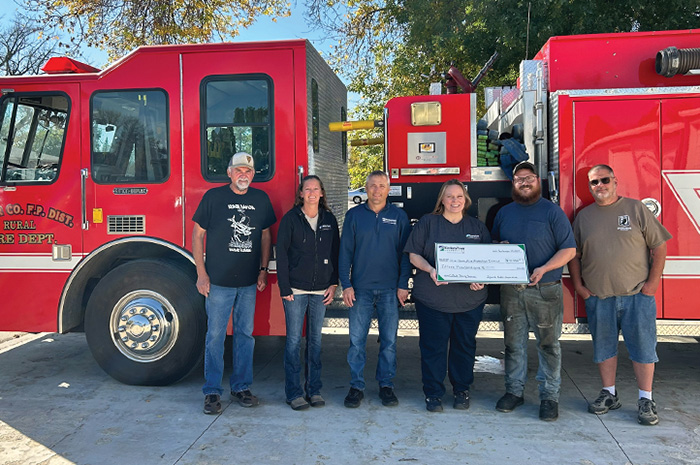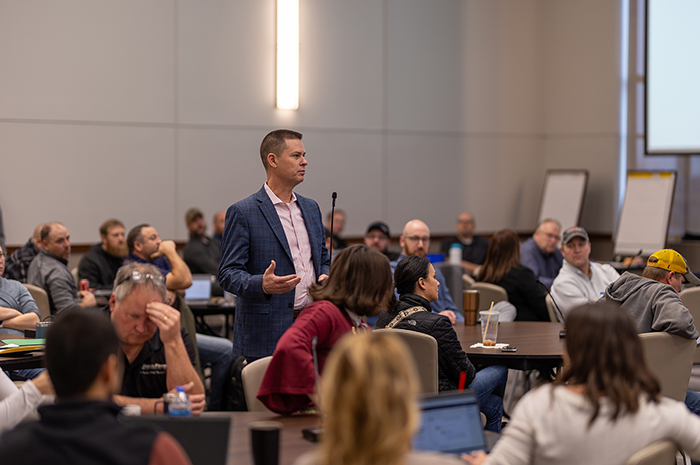Finding injection perfection
The latest Project Tundra simulations show promising properties for CO2 injection and storage near Minnkota's Milton R. Young Station.
Dan Laudal and Shannon Mikula are skeptical people. But it’s not their fault.
The roles of these members of the Minnkota Project Tundra team force them to find the potential flaws in every aspect of the ambitious carbon capture and storage initiative – Laudal as the project’s manager, and Mikula as geological storage lead and project legal counsel.
But the geologic testing results they have received lately are making it hard to be cynical.

“We’ve looked at each other and gone, ‘This is almost too good to be true,’” Mikula said. “You have to take a step back and say, we have put so much data into these models – they can’t get much more robust than what they are. We’ve done everything. The last step is we just need to do it.”
The models Mikula refers to are a set of 3D data that describe the properties of the deep subsurface beneath Minnkota’s Young Station, built on years of in-depth data collection, from core samples to seismic geophysical surveys. These geologic models have already revealed the Young Station sits upon suitable geology for carbon dioxide (CO₂) injection, but digital simulations the project team has recently initiated have exposed just how suitable that geology is. When coupled with the geologic models, the simulations predict how CO₂ captured from the Young Station would behave when injected into geologic formations deep within the subsurface around the coal-based plant.
Late in 2020, a crew ran a physical field test at one of Minnkota’s two test well injection sites, just south of Center, N.D. The test injected salt water into 10-foot sections of porous rock layers to determine the response at a range of injection rates and pressures. The formations accepted fluid at very high rates and at pressures that didn’t cause the rocks to break – a great sign for potential CO₂ injection.

Using what they already knew about the targeted formations and the new injection tests, reservoir engineers at the Energy & Environmental Research Center (EERC) ran digital simulations of how CO₂ injections in the 10-foot test areas would translate to the much larger planned storage scenarios.
“What we saw was much more promising than what we expected,” Mikula said. She added that the rate and volume at which the formation could accept CO₂ was beyond what was needed to safely inject and store the 4 million metric tons per year expected with Project Tundra, which indicated additional wells wouldn’t be needed. In fact, there is even potential to use fewer wells. “That is extremely good news, because that means we don’t have to reconfigure everything.”
“This is really a tool to optimize the project,” Laudal explained. “The simulation injects CO₂ at a certain rate over a certain period of time in a certain location, and we figure out what happens. From there, we can make tweaks to it to bring costs down and safely get the most CO₂ into the smallest footprint we can.”
EERC researchers will continue to run several simulations to find efficiencies in the injection and storage plan. Wes Peck, EERC geologist and assistant director for subsurface strategies, likens the process to determining the best way to file fans into a large football stadium.
“For the first test, we opened all the stadium doors and had people all run in as fast as they could. But that’s not what’s going to happen,” he said. “Number one, we won’t have that many people – or that much CO₂ – so we don’t need to open all the doors. And every time we open a door, it costs millions. If we can get everybody – all the CO₂ – in there in a reasonable amount of time by only opening a few doors, then that’s what we’re trying to do.”

Over the past few years, Peck has overseen a variety of research experts focused on carbon capture and storage connected to Project Tundra – geologists analyzing core samples, geophysicists using seismic data to expand the information derived from cores, and geomechanical and dynamic simulation modelers who bring all of that information together.
Mikula says that in addition to the EERC (experts on North Dakota’s geologic formations), Minnkota has built out a prestigious partnership network that will ensure a solid case for the project.
“We have Schlumberger, who ran the field test and analyzed that data, which is a global force to be reckoned with when it comes to CO₂ injection. And we have Oxy Low Carbon Ventures, arguably the biggest commercial operator using CO₂ in the world,” she said. “So we have three powerhouses who are at the top of their fields, telling us this is good news – you kind of want to pop a bottle of champagne and celebrate.”

However, there won’t be time to slow down and revel in the latest findings. Mikula and Laudal are now using all of the data they’ve gained to draft a permit application for Class VI storage. Once submitted, the application will face a lengthy review period. Minnkota hopes to have the permit by the end of 2021. In the meantime, the Project Tundra team will be speaking with investors who have much to gain with the project’s 45Q carbon capture tax credit.
There are many challenges yet to come, even before a decision is made to break ground on Project Tundra. However, the dozens of policy, technology, geology and engineering pros with Minnkota and the EERC – whose jobs are to question everything – are finally letting optimism overtake some of their natural skepticism.
Some of it.
“We’re doing our homework and crosschecking some of these situations with a critical eye, so that when we go forward, everyone is playing it a little bit cautious. If it turns out to be as good as it suggests, then there’s no problem – we don’t lose anything,” Peck said.
“It felt good to get to deliver this news to the team,” Mikula said, “to say that this piece is dropping into place as we thought it would.”
Main image: Project Tundra project manager Dan Laudal evaluates a diagram highlighting an injection output from one of the project’s proposed injection and storage zones. (Minnkota/Michael Hoeft)
...



